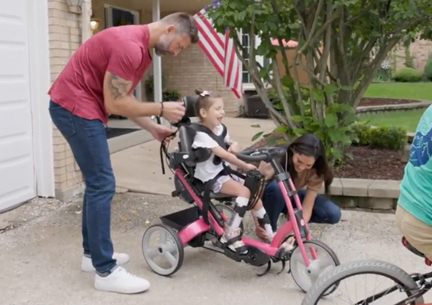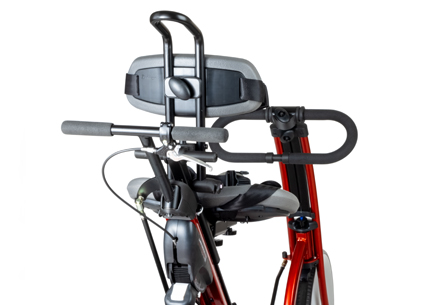Busting that Persistent Myth about Adaptive Bikes and Recreation
Eddie's Story
| July 2017 I love the adaptive tricycle and the opportunities it affords many of my students. But how often have insurance companies denied requests for adaptive tricycles because they only see the recreational purpose? For my students with the most severe disabilities, the tricycle is a life-saver, and often the only piece of adaptive equipment that will help them achieve functional gains and participation. I’ve seen it happen time and again. Take Eddie for example.
I love the adaptive tricycle and the opportunities it affords many of my students. But how often have insurance companies denied requests for adaptive tricycles because they only see the recreational purpose? For my students with the most severe disabilities, the tricycle is a life-saver, and often the only piece of adaptive equipment that will help them achieve functional gains and participation. I’ve seen it happen time and again. Take Eddie for example.
Meet Eddie
Eddie has sacral agenesis. He is six now, but I started working with him in Kindergarten. He used a manual wheelchair for mobility as he was unable to move his lower extremities and couldn’t bend or straighten his knees without help. He was essentially stuck at rest in the angle his knees were in his wheelchair.
An aide helped him with toileting (he could stand with AFO’s for short periods of time) and other mobility needs. Even with a gait trainer and HKAFO’s, he was not a functional ambulator. Research attributes this to the spinopelvic instability typically seen in the more severe presentations of sacral agenesis and has shown that this affects sitting balance as well.1 As we wanted Eddie to participate with his peers at recess, we sat him on the back of a two-seater tricycle with his legs sticking out while a classmate pedaled and an aide ran next to him to make sure he didn’t fall off.
Last Shot with an Adaptive Tricycle
But Eddie needed more. Children with similar conditions have the best outcomes when given opportunities to walk or at least make active efforts in walking as  this prevents worsening hip and knee flexion contractures and the inevitable surgeries that follow.1-3 We needed to get Eddie moving, but he had no safe gross motor activity he could participate in at school. That’s when I decided to try an adaptive tricycle. An adaptive tricycle has all the necessary supports to keep Eddie positioned safely and the pedaling provides reciprocal motion of the legs similar to walking. But, best of all, it would give him an opportunity to interact independently with his peers. Additionally, many of my students with similar diagnoses and limited mobility demonstrated functional gains with the tricycle. But I was nervous about trying it with Eddie. I didn’t know if he would have any motor control nor how significant his sacral agenesis was (we think he has type 3, but it has not been formally diagnosed). What if he didn’t make progress?
this prevents worsening hip and knee flexion contractures and the inevitable surgeries that follow.1-3 We needed to get Eddie moving, but he had no safe gross motor activity he could participate in at school. That’s when I decided to try an adaptive tricycle. An adaptive tricycle has all the necessary supports to keep Eddie positioned safely and the pedaling provides reciprocal motion of the legs similar to walking. But, best of all, it would give him an opportunity to interact independently with his peers. Additionally, many of my students with similar diagnoses and limited mobility demonstrated functional gains with the tricycle. But I was nervous about trying it with Eddie. I didn’t know if he would have any motor control nor how significant his sacral agenesis was (we think he has type 3, but it has not been formally diagnosed). What if he didn’t make progress?
Interestingly, research on sacral agenesis emphasizes the value of maintaining the sensory and proprioceptive components of the lower extremities despite their lack of power and stability as these are essential to standing and mobility.2 We decided to give the tricycle a shot. What could we lose?
Slow Start, Steady Improvement
At first, Eddie didn’t have enough mobility to bend his legs to pedal the adaptive bike (even after building the pedals up). So we spent the first therapy session with one foot velcroed to the pedal going back and forth to increase mobility. Then we switched sides. It took a while, but finally Eddie had enough ROM to go around one side, then the other. Then, with both feet on the pedals, we began to push him. (He did not have the strength to independently pedal the bike yet). But the ROM was there.
But by May (he received his trike in January), he had enough strength to independently pedal the bike around the quad three times (which is over 3,000 feet). We were ecstatic. Eddie hip-hiked a lot to push those pedals round, but he could do it!
Measurable, Objective Improvements
When Eddie came back from summer break we had to shave the built-up pedals down an inch because his legs grew. We also adjusted the harness to limit the amount of hip-hiking he does to encourage continued increases in knee ROM. This means a new goal as well. With increased knee ROM we expect Eddie to gain more independence to negotiate the stairs he utilizes for toileting. Right now his knees don’t bend enough to maintain his foot on the small step and go up or down.
 Triking is Fun, Therapeutic and Educational
Triking is Fun, Therapeutic and Educational
I look forward to using the Rifton adaptive bike as a “fun” modality to help him achieve more movement to reach other functional goals. In the past, traditional stretching techniques have been used for contractures, but more and more literature shows that this does not engage a child and is often ineffective.4-7On the other hand, research points to activity-based intervention (such as riding a tricycle) as the means to functional improvement.5, 8-13
I also see the tricycle as an educational tool. Typical or general education students participate in a gross motor activity at recess. They don’t just play board games or talk to friends. They run, play tag, skip-rope. An adaptive tricycle allows a student that can’t walk, run or even stand to have that opportunity to move during recess and join in the fun.
But most importantly, since riding the tricycle, Eddie’s quality of life improved, just like so many of my other students. And perhaps tricycle riding saved Eddie a surgery- who knows. It is such a great way to give the lower extremities proprioception, strength and movement when it is difficult to provide any other way.
Contact the author: AndersenCodi@gmail.com
References:
- Renshaw TS. Sacral agenesis. J Bone Joint Surg. 1978;60-A(3):373-83.
- Banta J, Nichols O. Sacral agenesis. J Bone Joint Surg. 1969;51-A(4):693-703.
- Bicakci I, Turgut ST, Icagasioglu A, Eglimez Z, Yumusakhuyla Y. A case of cauda regression syndrome: walking or sitting? Pan African Medical Journal. 2014;18(92).
- Pin T, Dyke P, Chan M. The effectiveness of passive stretching in children with cerebral palsy. Dev Med Child Neurol. 2006; 48(10): 855-62.
- Wiart L, Darrah J, Kembhavi G. Stretching with children with cerebral palsy: what do we know and where are we going? Pediatr Phys Ther. 2008; 20(2): 173-8.
- Katalinic OM, Harvey LA, Herbert RD et al. Stretch for the treatment and prevention of contractures. Cochrane Database Syst Rev. 2010; 8(9): CD007455.
- Shortland AP, Harris CA, Gough M et al. Architecture of the medial gastrocnemius in children with spastic diplegia. Dev Med Child Neurol. 2002; 44(3): 158-63.
- Novak I, McIntyre S, Morgan C, et al. A systematic review of interventions for children with cerebral palsy: state of the evidence. Dev Med Child Neurol. 2013; 55:885-910.
- Damiano DL. Activity, activity, activity: rethinking our physical therapy approach to cerebral palsy. Phys Ther. 2006; 86(11): 1534-40.
- Ketelaar M, Vermeer A, Hart H, et al. Effects of a functional therapy program on motor abilities of children with cerebral palsy. Phys Ther. 2001; 81(9): 1534-45.
- Valvano J. Activity-focused motor interventions for children with neurological conditions. Phys Occup Ther Pediatr. 2004; 24(1-2): 79-107.
- Apache RR. Activity-based intervention in motor skill development. Percept Mot Skills. 2005; 100:1011-20.
- Van der Putten A. Children with profound intellectual and multiple disabilities: the effects of functional movement activities. Clin Rehabil. 2005; 19(6): 613-20.




